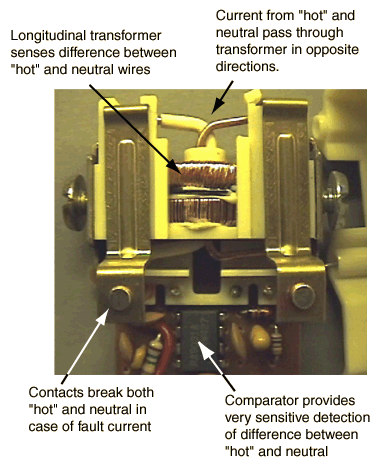Ground fault circuit interrupter


A Ground fault circuit interrupter, sometimes called a GFCI or simply a GFI, is an electrical safety device that is mandatory in locations throughout a home where water can come into contact with a wall plug. This includes bathrooms and kitchens. Only one outlet in a kitchen or bathroom needs to be a GFCI. Figure 1 shows how they work; see Figure 2 to see what this plug might look like in a bathroom.
[shock hazard|Electrocution]] can happen at currents that are far too low for a fuse or circuit breaker to detect. GFCIs make sure that all of the electric current going out of an electrical outlet goes back in the wall socket and not going through a person to make a path to (electrocution). Water and plumbing fixtures make a good path to ground, and thus need the additional safety feature of a GFCI.
The GFCI monitors the electric current in the hot line and the neutral line (see Figure 1). When these two currents are equal operation is normal and there is no ground fault. However when these two values become unequal by as little as 4-5 mA another path to the ground (ground fault) may be present, in this case the GFCI will open (with a response time of 1/30th of a second) thereby preventing electric shock to a person. A GFCI has a reset button to restore it to original conditions after it has opened the circuit, as well as a test button to ensure it is functioning properly.[3]
Using electrical devices near sinks and tubs is dangerous, so always exercise caution. GFCIs are an important safety feature of bathrooms and many kitchens, they should only be relied upon as a last resort. The first defense is to be careful with electronic devices near water. It's also a good idea to test the GFCI by pressing the 'test' button every month or so to make sure that it turns off the electricity. This can be done by plugging in something like a nightlight, or cell phone charger, and pressing the test button, if the power to the device turns off, the GFCI still works. If not, it should be replaced. GFCI's don't last nearly as long as houses do.
For Further Reading
For further information please see the related pages below:
- Electric circuit
- Circuit breaker
- Fuse
- Connecting homes to the electrical grid
- Or explore a random page!
References
- ↑ Hyperphysics. (Accessed July 28, 2015). Ground Fault Interrupter [Online], Available: http://hyperphysics.phy-astr.gsu.edu/hbase/electric/gfi.html
- ↑ Wikimedia Commons [Online], Available: https://commons.wikimedia.org/wiki/File:GFCIReceptacle.jpg
- ↑ R.T. Paynter, “Basic Electric Components and Meters,” in Introduction to Electricity, 1rst ed. NJ: Prentice-Hall, 2011, ch. 8, sec. 8.2, pp. 341-346.

